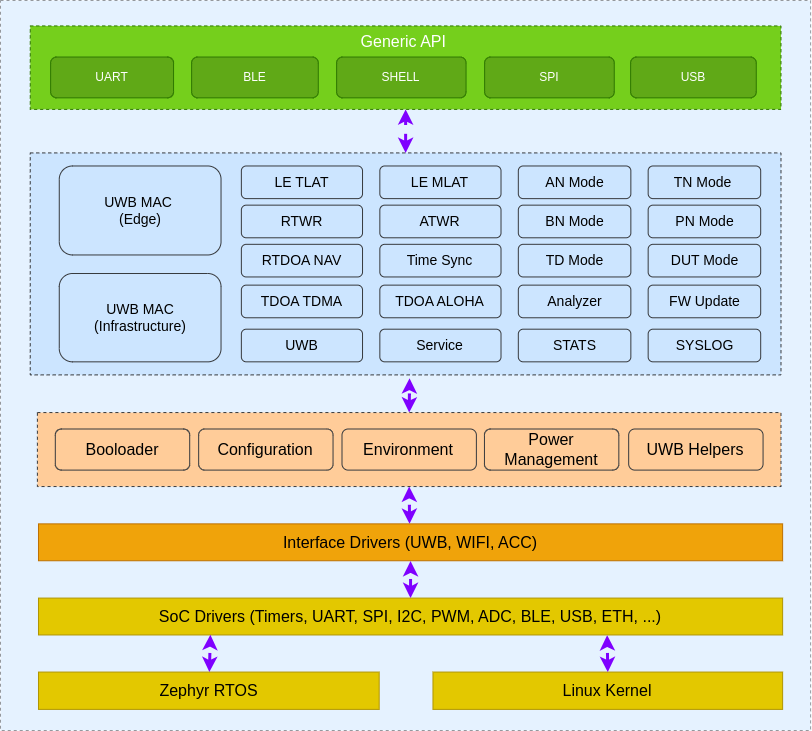LEAPS UWBS
LEAPS UWBS is a fully-embedded and advanced UWB Sub-System that covers a wide range of use cases. One UWB Sub-System is configurable in different modes and profiles. The UWBS can run as an Anchor, a Tag or a Gateway. The networking profiles are fully scalable with high capacity and low-power.
Key Features
Versatility makes it easy to balance the system requirements, costs, deployment time and maintenance complexity. Applications range from simple distance proximity to high-speed tracking or navigation of an unlimited receiver.
It integrates a sophisticated UWBMAC that allows adaptive clustering of the infrastructure devices, air-time reuse, slot allocation, etc. A scalable, proven collision detection, collision avoidance and collision resolution allow the system to function robustly in complex environments.
Supported measurement techniques include TWR, DL-TDoA and UL-TDoA. Integrated location engines allow the device to operate independently in the navigation mode using DL-TDoA or TWR.
Superior power management provides a long battery lifetime for both TWR and TDoA modes.
Used terminology
Anchor: Has fixed location.
Tag: Changes location, determines position dynamically with the help of anchors.
Gateway: Provides stateful information about network nodes (read/introspect), caches node information, might even collect data and track history, provides means for the application layer to interact with UWB network elements (a.k.a. interaction proxy).
Node: Network node (anchor, tag, gateway, …).
LE: Location engine.
CORE_INT: GPIO pin reserved by firmware to inform users about new UART/SPI interface events.
TLV: Type-Length-Value encoding.
UWBS UWB sub-system.
UWB RF
LEAPS RTLS , PANS PRO RTLS , PANS v2.0 |
Qorvo FiRa |
Custom stack (DW3000 RF) |
||
|---|---|---|---|---|
Channel |
5 |
5,9 |
9 |
5,9 |
PRF |
64M |
64M |
64M |
16M, 64M |
Preamble Length |
128 |
128 |
64 |
32, 64, 72, 128, 256, 512, 1024, 1536, 2048, 4096 |
PAC Size |
8 |
8 |
8 |
4, 8, 16, 32 |
Rx code |
9 |
9 |
9 |
1-29 (PRF16: 1-8; PRF64: 9-24) |
Tx code |
9 |
9 |
9 |
1-29 (PRF16: 1-8; PRF64: 9-24) |
SFD Type |
IEEE 802.15.4 short 8-symbol |
IEEE 802.15.4 short 8-symbol |
IEEE 802.15.4z defined 8-symbol |
IEEE 802.15.4 short 8-symbol, Decawave-defined 8-symbols, Decawave-defined 16-symbols, IEEE 802.15.4z defined 8-symbol |
Data Rate |
6.8 Mbit/s |
6.8 Mbit/s |
6.8 Mbit/s |
6.8Mbit/s, 850kbits/s |
PHR Mode |
DW proprietary extended frames PHR mode |
DW proprietary extended frames PHR mode |
Standard |
Standard, Extended (DW proprietary extended frames PHR mode) |
PHR Rate |
Standard |
Standard |
Standard |
Standard, PHR at data rate (6M81) |
SFD Timeout |
129 |
129 |
65 |
Configurable |
STS Mode |
- |
OFF |
OFF |
Off, 1, 2, No data, Super Deterministic Codes |
STS Length |
- |
0 |
0 |
32, 64, 128, 256, 512, 1024, 2048 |
PDOA Mode |
- |
M0 |
M1 |
M0, M1, M3 |
Hardware supported |
UWB IC: DW1000 |
UWB IC: DW3000 family, QM33 family |
UWB IC: DW3000 family, QM33 family |
UWB IC: DW3000 family, QM33 family |
Modules: DWM1001C |
Modules: DWM3001C, Murata Type2AB |
Modules: DWM3001C, Murata Type2AB |
Modules: DWM3001C, Murata Type2AB |
BLE RF
We are supporting 2M PHY, frequency band as 2.4GHz, 40 channels with 2MHz spacing (more detail can be found in BLE specification 5.3).
